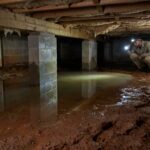Essential Techniques for Effective Basement Waterproofing: Protect Your Home from Moisture Damage
When it comes to home maintenance, few things are as crucial yet often overlooked as basement waterproofing. If you’ve ever stepped into a damp basement and felt the chill creep up your spine, you know exactly what we’re talking about. Moisture can lead to mold growth, structural damage, and a whole host of problems that could turn your cozy abode into a moldy dungeon. So, let’s dive into essential techniques for effective basement waterproofing and help you protect your castle from moisture damage.
Understanding the Importance of Basement Waterproofing
Before we roll up our sleeves and get to work, it’s vital to understand why basement waterproofing is so important. First, a damp basement can create an ideal environment for mold and mildew, which can affect your health and the air quality in your home. Second, excess moisture can weaken foundation walls, leading to costly repairs down the line. Lastly, if you ever plan to sell your home, potential buyers may not be too thrilled about a wet basement (and neither will their inspectors).
Now, you might wonder, “Can’t I just toss a few towels down there and call it a day?” Well, while that’s certainly one way to tackle a monsoon, it’s not the most effective. Let’s explore some tried-and-true techniques to keep your basement dry and happy.
1. Exterior Drainage Solutions
Think of exterior drainage systems as the first line of defense against nature’s watery onslaught. Proper grading and drainage can prevent rainwater from pooling around your foundation. Here are some critical steps to consider:
**a. Grading:**
Ensure that the ground around your home slopes away from the foundation. A slope of at least 6 inches over the first 10 feet is typically recommended. This little incline helps direct water away from your basement, much like how a well-timed dodge can help you avoid a flying soccer ball.
**b. Gutters and Downspouts:**
Make sure gutters are clean and in good repair. Clogged gutters are like blocked arteries—bad for your home’s health! Ensure downspouts extend at least 5-10 feet away from the foundation to give those raindrops a fighting chance to escape.
**c. French Drains:**
Consider installing a French drain system around your foundation. These are perforated pipes buried in gravel that collect water and direct it away from your home. Think of them as tiny water highways, helping keep your basement dry and your worries at bay.
2. Interior Drainage Solutions
If Mother Nature still finds her way indoors, it might be time to look at interior drainage solutions. These systems work hard to keep water at bay once it breaches your fortress.
**a. Sump Pumps:**
A sump pump is like a trusty sidekick against flooding. It sits in a pit in your basement, collecting water and pumping it away when levels rise. Choosing a reliable, high-quality sump pump can save the day during torrential downpours or rapid snowmelt.
**b. Interior Drain Tile Systems:**
These systems are installed along the perimeter of your basement floor and connect to the sump pump. They redirect any incoming water to the pump. When combined with a sump pump, you have a solid moisture management system that would make even the most experienced superhero proud.
3. Vapor Barriers
Imagine having a magical shield protecting your basement from moisture! While we won’t promise you superhero powers, installing vapor barriers is the next best thing.
**a. Purpose of Vapor Barriers:**
These materials help prevent moisture from the ground or external sources from entering your basement. Typically made of polyethylene sheeting, they are applied to walls or floors before finishing a basement. They work tirelessly to keep that musty smell and dampness at bay.
**b. Installation Tips:**
When installing a vapor barrier, make sure it’s sealed tightly at seams and edges. Just like trying to eat soup without a bowl, loose edges won’t do you any good!
4. Waterproofing Paint and Sealants
Sometimes, a bit of DIY magic can go a long way in keeping moisture out. Enter waterproofing paint and sealants.
**a. Waterproofing Paints:**
There are specially designed paints that can be applied to basement walls to repel moisture. It’s like giving your walls a raincoat! Just make sure the surface is clean and free of cracks before applying.
**b. Sealants:**
For any visible cracks in your foundation walls, use a high-quality sealant. This will help prevent water infiltration through those pesky gaps. A little effort now can pay dividends by avoiding significant problems down the line.
5. Proper Ventilation
Yes, we’re turning the spotlight on ventilation—because nobody wants a damp basement that smells like a gym bag! Good air circulation can help prevent humidity buildup.
**a. Foundation Vents:**
If your basement has a dirt floor or is a crawlspace, consider installing foundation vents to promote airflow. Be mindful of closing these off during winter to avoid freezing pipes!
**b. Dehumidifiers:**
Installing a dehumidifier in your basement can also help remove excess moisture from the air. You’ll feel like a moisture-fighting wizard, and your basement will thank you for it!
6. Landscaping Considerations
Your yard can play a significant role in your basement’s moisture levels. A little landscaping finesse can go a long way in directing water where it should go—away from your foundation.
**a. Plant Placement:**
Be strategic about where you plant trees and shrubs. Large roots can divert water toward your basement, while certain plants can absorb moisture. Positioning vegetation wisely can help keep your foundation dry and looking great!
**b. Hardscaping:**
Consider incorporating hardscape features like patios and retaining walls that can guide water away from your home. Think of it as creating pathways for rainwater to escape on its own terms.
7. Regular Maintenance Checks
Just like you wouldn’t ignore a check engine light, regular maintenance checks can help catch issues before they escalate. Keep an eye on key areas of your basement and exterior for signs of moisture issues.
**a. Inspecting for Cracks:**
Regularly inspect your foundation for any new cracks or signs of water leaks. Treating these promptly can save you from facing expensive repairs later.
**b. Monitoring Humidity Levels:**
Investing in a hygrometer can help you monitor humidity levels in your basement. Keeping humidity below 60% is generally recommended for mold prevention.
8. Professional Help
Let’s face it; sometimes, DIY projects don’t go as planned. If you find yourself drowning in the intricacies of basement waterproofing, don’t hesitate to reach out to a professional. They have the tools, experience, and knowledge to tackle any challenges your basement presents.
Conclusion
Basement waterproofing doesn’t have to be a daunting task filled with uncertainty and dread. Armed with the right knowledge and techniques, you can effectively protect your home from moisture damage. Remember, prevention is always better than cure—especially when it comes to maintaining your castle. From exterior drainage solutions to vapor barriers, each technique plays a vital role in ensuring your basement remains a safe and dry space.
So, roll up your sleeves, embrace your inner handyman (or handywoman), and take the necessary steps to safeguard your home. With a little effort and dedication, you can turn your basement into a dry and welcoming part of your home instead of an unwelcome swamp. Cheers to a moisture-free future!


